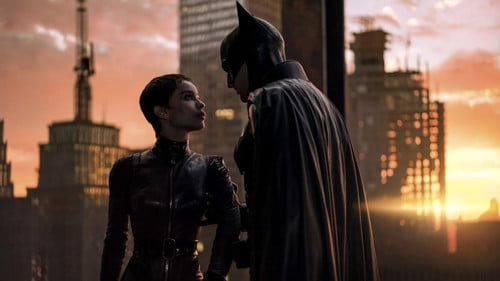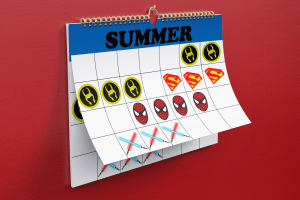‘The Batman’: A Faithful Adaptation of the Comics
Director Matt Reeves’ gritty and realistic new vision of Batman does not disappoint

VIA WARNER BROS
This Batman movie is different from many others, but that doesn’t make it any less awesome to diehard fans.
March 16, 2022
Riddle me this. What is dark, bleak and gritty, with Nirvana pounding in the background?
The answer would be “The Batman,” the most anticipated movie of the year, directed by Matt Reeves and starring Robert Pattinson as the titular character.
After watching dozens of teaser trailers, promo clips and cast interviews, I doubted that the movie could live up to my expectations that this would be the greatest Batman movie ever. When the final credits rolled, I couldn’t help but sit there in the movie theater and start comparing it to past Batman movies, especially the Christopher Nolan trilogy.
This Batman is completely different.
All around me, people immediately started asking each other what they thought, and there were a lot of different reactions. In the row in front of me, a group said, “I really wanted to like it, but as the movie kept going on longer and longer, I couldn’t help but dislike it.”
The couple next to me was still trying to understand the final scene, and when I explained what it meant, their jaws dropped, and they just shook their heads in disbelief.
The majority of my friends said that this was the best Batman movie ever made, and when they all turned to me, being that I’m the Batman fan of the group, I couldn’t help but just nod my head in agreement and hold up the number one.
That sparked an instant reaction from one of my friends who said, “This didn’t even touch the Nolan trilogy. You’re crazy if you think this is on the level of ‘The Dark Knight’! I mean, I liked it, but it’s completely different.” And he’s right: This Batman is completely different.
In the shadows with a mask, he lights up the city, like the Bat-Signal, a symbol of justice and hope for the city’s future, and for himself.
“The Batman” will not be for everyone — for some, three hours of a rain-soaked, grimy Gotham City mixed with a reclusive and soft-spoken Bruce Wayne is a little too much. For others like myself, I couldn’t help but smile, as this was the closest adaptation to the character from the comics.
Bruce Wayne is finally shown in his true manner on the big screen — lost and distraught, using the Batman as a way to unleash his trauma from the loss of his parents by seeking vengeance against Gotham’s scum. Unlike other portrayals of Bruce Wayne, like in the Nolan trilogy with Christian Bale as Batman, this Bruce Wayne does not have the confidence we are accustomed to.
We find him one year after he has become the Batman, still figuring out how to use his armor and gadgets, and, more importantly, still figuring out what the Batman stands for. As Bruce Wayne says in the opening narration, he has become a nocturnal animal; all the nights blend together as he doubts he is even making a change with all the corruption and crime in Gotham. He’s a recluse, removed from society in the daytime. It is in the darkness that he finds his true self, the Batman. In the shadows with a mask, he lights up the city, like the Bat-Signal, a symbol of justice and hope for the city’s future, and for himself.
Reeves could not have chosen a better villain to go up against Batman than the Riddler (Paul Dano) as he unmasks Batman’s insecurities, tearing down the goodness and hope that Bruce Wayne believed his family stood for.
The Riddler is a psychopathic serial killer, stalking Gotham’s corrupt politicians and police, murdering them and using social media to expose their lies. His motivation is uncomfortably similar to Batman’s: getting rid of Gotham’s corruption.
After each murder, the Riddler leaves Batman with a card and a clue for his next move. This eventually leads to Bruce Wayne discovering the truth about his family, as even the best of Gotham can’t help but become a part of the corruption that plagues the city.
Dano did an exceptional job playing the Riddler as he captured the character’s dark humor, intelligence and insanity better than any previous portrayals of the Riddler. Watching his performance is chilling as you consider how someone so politically and socially torn like the Riddler could emerge in a society like ours, with people desperate to follow the next polarizing figure that promises changes.
As the comics say, Batman is the world’s greatest detective.
The Riddler inspires other troubled and angered people like himself to take a stand against Gotham’s powerful by taking arms and raiding one of Gotham’s symbols of unity, the Gotham Square Garden. This sequence was horrifyingly similar to the raid on the U.S. Capitol on Jan. 6, 2021. What is even more horrifying is the fact that the director said the script was written in 2017, so our society has already in some ways become Gotham City, controlled by mass corruption, unease and violence.
One of the unique aspects of this take on Batman is how we get to see Batman as a detective, showing his intelligence which has usually been put to the side in previous Batman movies. As the comics say, Batman is the world’s greatest detective, and we finally get a chance to see that as Batman’s detective skills are shown with the solving of each riddle.
“The Batman” has all the normal trademarks of other Batman movies — the Bat-Signal, an epic Batmobile chase scene, insane villains and action sequences that will make you believe that you’re like Batman’s right-hand man, Robin, joining in on the beatdown of Gotham’s criminals.
What ultimately separates this adaptation from its predecessors is its tone. Drawing inspiration from movies like “Se7en,” “Zodiac” and “Taxi Driver,” Reeves is able to create a realistic and gritty tone, transporting the audience into a world that isn’t as foreign to us as we may think.
That’s the magic of “The Batman” — the corruption that runs the city and the Riddler’s use of society’s anger to start an uprising are relatable, making the movie realistically horrifying.
In the end, as Batman emerges from the destruction of the Riddler’s grand plan to bring down Gotham, Nirvana’s “Something in the Way” starts playing again. In the beginning, as the title of the song suggests, there is something in the way not allowing Bruce to function in society or be comfortable with himself. He struggles to deal with his parents’ deaths, and he does not envision a happy future in Gotham.
However, the song means much more in the ending, representing Bruce Wayne and Batman’s transformation throughout the movie. Even in a society as bleak as Gotham, Batman provides hope for a better future — a symbol of light and justice. He is the watchful protector, and when his signal hits the sky, it’s a warning that something will always be in the way, stopping Gotham’s criminals from destroying the city for good.














